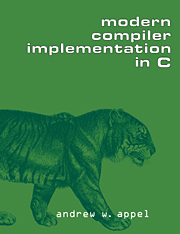Book contents
- Frontmatter
- Contents
- Preface
- Part I Fundamentals of Compilation
- 1 Introduction
- 2 Lexical Analysis
- 3 Parsing
- 4 Abstract Syntax
- 5 Semantic Analysis
- 6 Activation Records
- 7 Translation to Intermediate Code
- 8 Basic Blocks and Traces
- 9 Instruction Selection
- 10 Liveness Analysis
- 11 Register Allocation
- 12 Putting It All Together
- Part II Advanced Topics
- Appendix: Tiger Language Reference Manual
- Bibliography
- Index
8 - Basic Blocks and Traces
Published online by Cambridge University Press: 05 June 2012
- Frontmatter
- Contents
- Preface
- Part I Fundamentals of Compilation
- 1 Introduction
- 2 Lexical Analysis
- 3 Parsing
- 4 Abstract Syntax
- 5 Semantic Analysis
- 6 Activation Records
- 7 Translation to Intermediate Code
- 8 Basic Blocks and Traces
- 9 Instruction Selection
- 10 Liveness Analysis
- 11 Register Allocation
- 12 Putting It All Together
- Part II Advanced Topics
- Appendix: Tiger Language Reference Manual
- Bibliography
- Index
Summary
ca-non-i-cal: reduced to the simplest or clearest schema possible
Webster's DictionaryThe trees generated by the semantic analysis phase must be translated into assembly or machine language. The operators of the Tree language are chosen carefully to match the capabilities of most machines. However, there are certain aspects of the tree language that do not correspond exactly with machine languages, and some aspects of the Tree language interfere with compiletime optimization analyses.
For example, it's useful to be able to evaluate the subexpressions of an expression in any order. But the subexpressions of Tree.exp can contain side effects – eseq and call nodes that contain assignment statements and perform input/output. If tree expressions did not contain eseq and call nodes, then the order of evaluation would not matter.
Some of the mismatches between Trees and machine-language programs are:
The cjump instruction can jump to either of two labels, but real machines' conditional jump instructions fall through to the next instruction if the condition is false.
eseq nodes within expressions are inconvenient, because they make different orders of evaluating subtrees yield different results.
call nodes within expressions cause the same problem.
call nodes within the argument-expressions of other call nodes will cause problems when trying to put arguments into a fixed set of formal-parameter registers.
Why does the Tree language allow eseq and two-way cjump, if they are so troublesome? Because they make it much more convenient for the Translate (translation to intermediate code) phase of the compiler.
Information
- Type
- Chapter
- Information
- Modern Compiler Implementation in C , pp. 176 - 190Publisher: Cambridge University PressPrint publication year: 1997
